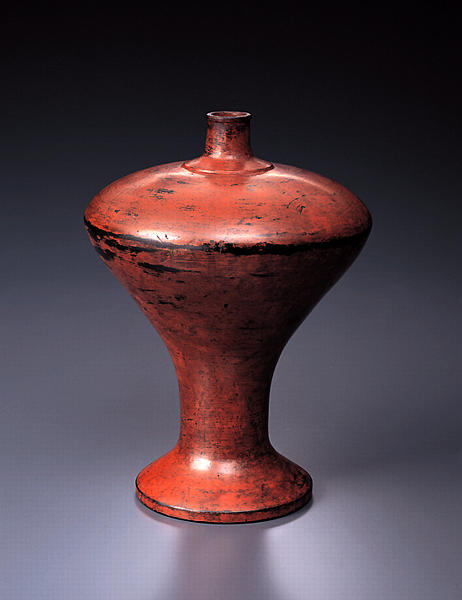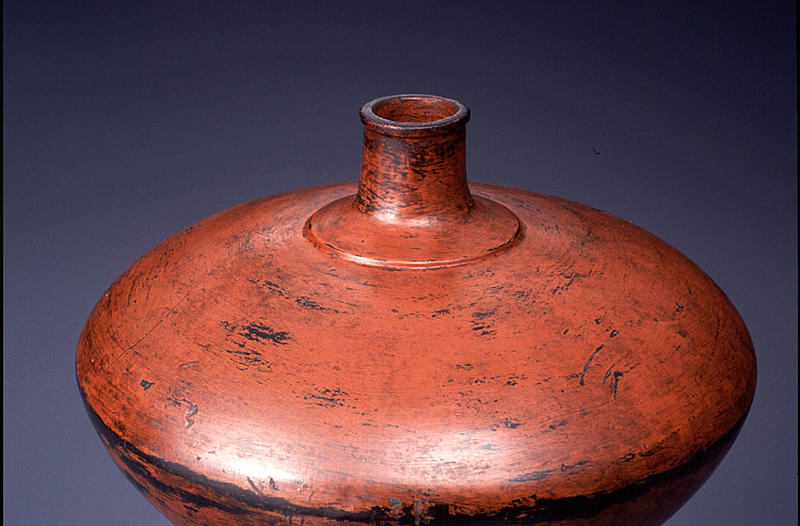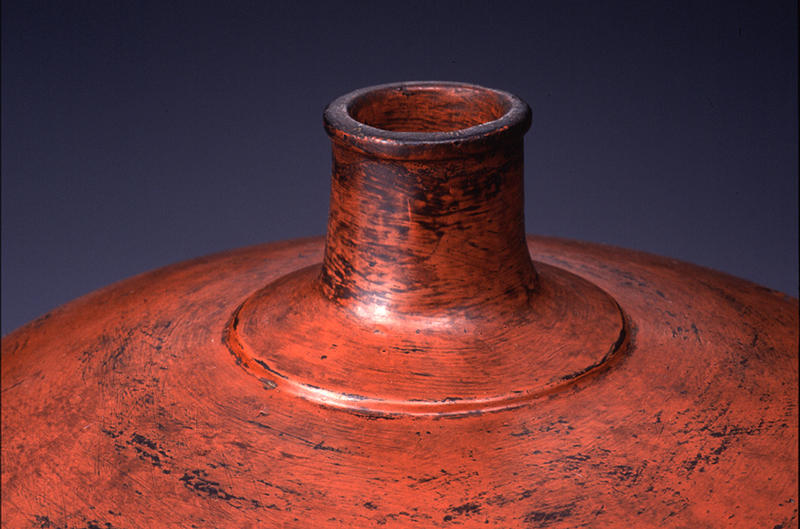根来瓶子
- 室町時代
- 14c
- 木製黒漆、朱漆塗
- H-31.8 D-24
この作品は欅材による轆轤成形の瓶子で、玉縁を巡らした円筒形の注口部(挿図)は
別製のものを接合している。内刳は注口接合部から胴体部の半ばあたりまで施されるのみで、過半はムクのままであるため、きわめて重量感に富む。黒漆の下地に朱漆の上塗が施された、いわゆる根来塗で、長年の使用に上塗の朱漆が摩滅して雅味豊かな塗り肌を呈している。S字形の輪郭を持ち、基台の立ち上がりが薄手という古様を示す。神饌具として、本来一対のものであったと考えられる。
室町時代 14世紀
高:31.8cm 胴径:23.5cm 底径:14.7cm
ケヤキ材による轆轤挽き成形の瓶子で,玉縁をめぐらした円筒形の注口部は別製のものを接合している。内刳りは注口接合部から胴体部の半ばあたりまで施されるのみで,過半はむくのままであるため,極めて重量感に富む。
総体黒漆の下塗りを行ったのち,底裏を除く全面に朱漆を塗布して仕上げている。したがって,長年の使用で上塗りの朱漆が磨滅して黒地を露出し,俗に「根来」と称される朱漆器特有の雅味豊かな塗り肌を呈している。
瓶子は,延長5年(927)に完成した。『延喜式』巻四十「造酒司」の項に,釈奠料として「瓶子二口 平文胡瓶二口」と記されていることからも,当時から酒器として用いられていたことは確かである。もちろん,当時の瓶子の主流は金属製ややきものであり,その形状が中国器物の影響下にあったことは否めない。
木製漆塗の瓶子は平安時代の記録には認められず,現存する遺品も鎌倉時代前半期に比定されるものが上限である。13世紀の絵巻である「後三年合戦絵巻」(重要文化財・東京国立博物館蔵)には,中国宋代の青磁を彷彿させる瓶子が描かれており,筒状の小さな注口をつけ,おおらかな曲面を呈する肩張りの作りがS字状の弧線を描いて腰部で細く締まり,裾に向かって次第に末広がりになるのが特徴的である。梅瓶とも呼ばれるこの種の器物は,やがて古瀬戸の瓶子にも採り入れられたが,木製朱漆塗瓶子の流行もそのような時代の好尚のなかに胚胎したのであろう。岐阜・白山長瀧神社の朱漆塗瓶子はその先例となる遺品であるが,中世期の事例はいずれもS字形の輪郭をもち,それらのなかでは基台の立ち上がりの薄手のものが古様である。この瓶子もその典形を示す。なお朱漆塗瓶子はいずれも神饌具と考えられ,元来は二口一対のものとして神前に供えられてきた。(河田)
Catalogue Entry
Muromachi period, 14th century
Height, 31.8cm; torso diameter, 23.5cm;
base diameter, 14.7cm
Keyaki (zelkova) wood was lathe-turned to form the exterior shape of this sake bottle, and then a separate circular, cylindrical spout surrounded by beading was attached to the body. The interior hollowing extends from the point where the spout is attached to about halfway into the torso area, and the remaining lower half of the body was left solid. This results in an extremely heavy sensibility and actual form.
The entire bottle was coated in black lacquer and, with the exception of the bottom of the base, was finished with red lacquer. Over long years of use, this upper layer of red lacquer has begun to chip off, exposing the black lacquer underneath and forming the distinctive lacquer appearance of the worn red lacquer wares which have been dubbed "Negoro" wares.
This form of bottle was mentioned in the sake brewery section of volume 40 of the Engishiki completed in 927 (Encho 5), and thus we can see that it was clearly used at that time as a sake vessel. Of course, the majority of bottles of this type from this period were made of either metal or ceramics, and their shape was undoubtedly influenced by Chinese utensils.
Lacquered wood bottles of this shape cannot be confirmed in Heian texts, and existing examples only date as far back as the Kamakura period. The 13th century illustrated handscroll The Battle of Gosannen (Important Cultural Property, Tokyo National Museum) depicts a sake bottle of this shape which resembles the celadons of China's Song dynasty. This bottle shows the special characteristics of this bottle type, namely its small cylindrical spout, swelling at the shoulders into a generous curve that fans outward before returning to a narrow hip and flaring out again to a broad foot, thus exhibiting an S-shaped form overall. This type of vessel, which is also called a mei ping jar in Chinese, was also produced at the Ko-Seto kilns, and it is likely that lacquered wood versions of this vessel shape would have developed around this time as a result of the popularity of the ceramic versions. Early examples of this form of red lacquer sake bottle can be found at the Hakusan Nagataki Shrine, Gifu prefecture. All of the examples from Japan's medieval period exhibit an S-shaped outline base, and those which have a thin rise from the foot are the older form of the vessel type. This sake bottle is also of this earlier form. It seems that all of these red lacquer sake bottles were used as shrine furnishings, and originally a pair of these would have been placed as offerings on the altar before the central shrine. SK
解説(春の玉手箱)
欅材による轆轤挽き成形の瓶子で,玉縁をめぐらした円筒形の注口部は別製のものを接合している。内刳りは注口接合部から胴体部の半ばあたりまで施されるのみで,過半はむくのままであるため,極めて重量感に富む。総体黒漆の下塗りを行ったのち,底裏を除く全面に朱漆を塗布して仕上げている。したがって,長年の使用で上塗りの朱漆が磨滅して黒地を露出し,俗に「根来」と称される朱漆器特有の雅味豊かな塗り肌を呈している。
瓶子の形状は、中国器物の影響からなり、梅瓶とも呼ばれるこの種の器物は,やがて古瀬戸の瓶子にも採り入れられたが,木製朱漆塗瓶子の流行もそのような時代の好尚のなかに胚胎したのであろう。朱漆塗瓶子はいずれも神饌具と考えられ,元来は二口一対のものとして供えられてきた。凛とした気配が漂っており、神前に具えられるにふさわしい姿といえよう。なお本作に酷似する瓶子がサントリー美術館に所蔵されている。


